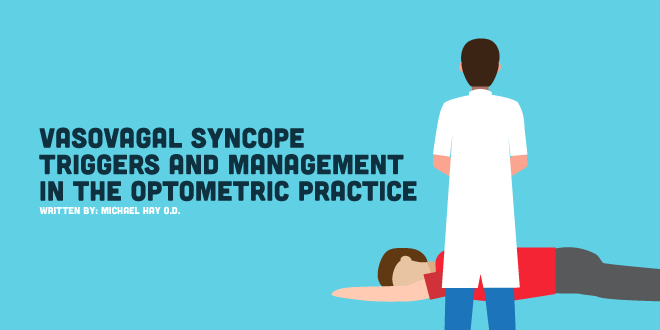No matter how rare something is, you need to be prepared for it, and that includes vasovagal syncope.
Something to remember: “it’s rare until it’s in your chair.”
Recently, I had a patient present for a comprehensive examination. Her last exam had been six years prior and did not note any previous health issues. The entire exam was unremarkable, so I proceeded to discuss dilation with the patient.
Soon after instilling the drops (1 drop 1% Tropicamide and one drop of 2.5% Phenylephrine) she stated that she was feeling like she was going to faint.
And she did.
Not a typical day in any optometric practice, but you should be prepared for vasovagal syncope if and when it occurs.
Syncope is the transient, temporary loss of consciousness and posture.
Vasovagal as seen in syncope has been used since the early 1900s and has become synonymous with the term “fainting.” Vasovagal syncope is a reaction centered around the fight-or-flight response which occurs when individuals experience a perceived or actual danger or threat, especially when it involves pain.
The body is overreacting to certain triggers. The vagus nerve is over-stimulated and causes the body’s peripheral blood vessels (hands, arm, legs and toes) to dilate which lowers the blood pressure, and the heart slows down (bradycardia). This effect decreases the ability of the heart to pump blood upward to the brain, so there is no oxygen sent to the brain and fainting occurs.
Fortunately, the body can correct this and returns to normalcy within a matter of seconds. Much like a computer turning off and turning back on after resetting itself.
Common Trigger Factors of Vasovagal Syncope in the Optometric Practice:
- Dilation
- Contact lens insertion
- Applanation Tonometry/Gonioscopy
- Punctal plug insertion/removal
- Foreign body removal
When you have a patient that experiences a vasovagal episode, they may have:
- a pale complexion
- exhibit jerky abnormal movements
- have a slow, weak pulse
- and dilated pupils
Recovery generally begins in less than a minute.
Being Prepared: What to do when encountering a vasovagal syncope event
1) First of all, it is important to stay calm.
This may be easier said than done. Being prepared for when this happens will allow you to be calm during the syncope.
2) Keep the patient safe.
Most of the time during fainting, patients will be seated which lessens the risk of injury to the patient. However, it is important to remember to keep the patient safe during the episode. DO NOT leave the room as it is happening. If you need assistance, wait until the patient has awoken.
3) Lower the head and raise the feet.
A helpful mnemonic to remember is “If the face is red, raise the head; If the face is pale, raise the tail (feet).”
In this case, the patient will be pale due to the loss of blood in the head, so therefore, you would lay the patient back and raise the feet to restore blood to the head. As I mentioned earlier, most patients will be sitting in the exam chair when it happens, so it will be relatively easy to lay the chair back and lift the feet.
Remember to follow your ABCs of CPR (if needed):
- Airway: Use the head tilt, chin lift to gain a neutral head position and secure the airway.
- Breathing: Once the airway is secure, use the look, listen and feel technique to make sure the patient is breathing.
- Circulation: Check the Carotid Artery for a pulse to ensure proper circulation.
After a vasovagal response, it is important not to move the patient.
Let the patient rest in a supine position for 15 to 30 minutes. Loosen neckties and tight clothing around the neck. With the blood returning to the head, the patient may be seen sweating. Applying a cool damp cloth to the head will offer some relief. Assist the patient in returning to an upright position slowly.
If you DO NOT know the cause of the vasovagal syncope (no known trigger factor), call 911 and have the patient monitored.
If you know what the trigger factor was, document that in the record and release the patient. I would also take the extra step and contact someone to pick up the patient as not to risk another episode from occurring.
20/20 Hindsight
After my patient’s Vasovagal response, I asked her if this has ever happened to her before? She stated, “yes, every time I get a shot.”
This happens so rarely; it wasn’t something I addressed on a regular basis. Moving forward, I will ask my patients if they have had any adverse effects after things like shots, seeing blood, standing for long periods of time or heat exposure. If anything, it will keep me aware that this can happen in my practice any day of the week.
Vasovagal syncope is uncommon, but a very real condition that you should be prepared to manage in your practice.
